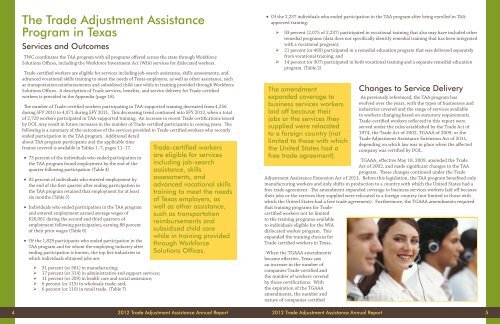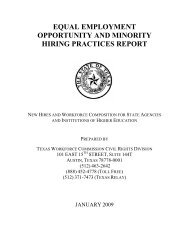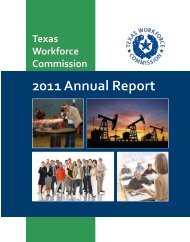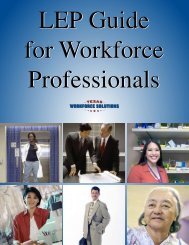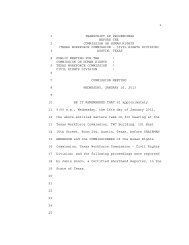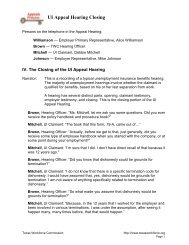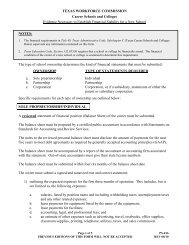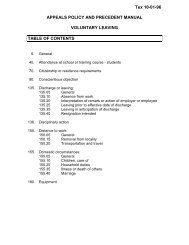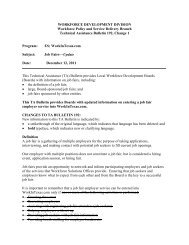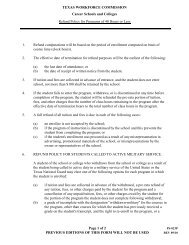2012 TAA - Texas Workforce Commission
2012 TAA - Texas Workforce Commission
2012 TAA - Texas Workforce Commission
You also want an ePaper? Increase the reach of your titles
YUMPU automatically turns print PDFs into web optimized ePapers that Google loves.
The Trade Adjustment Assistance<br />
Program in <strong>Texas</strong><br />
Services and Outcomes<br />
TWC coordinates the <strong>TAA</strong> program with all programs offered across the state through <strong>Workforce</strong><br />
Solutions Offices, including the <strong>Workforce</strong> Investment Act (WIA) services for dislocated workers.<br />
Trade-certified workers are eligible for services including job-search assistance, skills assessments, and<br />
advanced vocational skills training to meet the needs of <strong>Texas</strong> employers, as well as other assistance, such<br />
as transportation reimbursements and subsidized child care while in training provided through <strong>Workforce</strong><br />
Solutions Offices. A description of Trade services, benefits, and service delivery for Trade-certified<br />
workers is provided in the Appendix (page 18).<br />
The number of Trade-certified workers participating in <strong>TAA</strong>-supported training decreased from 4,256<br />
during SFY 2010 to 4,071 during SFY 2011. This decreasing trend continued into SFY <strong>2012</strong>, when a total<br />
of 2,729 workers participated in <strong>TAA</strong>-supported training. An increase in recent Trade certifications issued<br />
by DOL may result in future increases in the number of Trade-certified participants in coming years. The<br />
following is a summary of the outcomes of the services provided to Trade-certified workers who recently<br />
ended participation in the <strong>TAA</strong> program. Additional detail<br />
about <strong>TAA</strong> program participants and the applicable time<br />
frames covered is available in Tables 1–7, pages 11–17.<br />
• 73 percent of the individuals who ended participation in<br />
the <strong>TAA</strong> program found employment by the end of the<br />
quarter following participation (Table 4)<br />
• 92 percent of individuals who entered employment by<br />
the end of the first quarter after ending participation in<br />
the <strong>TAA</strong> program retained that employment for at least<br />
six months (Table 5)<br />
• Individuals who ended participation in the <strong>TAA</strong> program<br />
and entered employment earned average wages of<br />
$20,061 during the second and third quarters of<br />
employment following participation, earning 88 percent<br />
of their prior wages (Table 6)<br />
• Of the 1,829 participants who ended participation in the<br />
<strong>TAA</strong> program and for whom the employing industry after<br />
ending participation is known, the top five industries in<br />
which individuals obtained jobs are:<br />
‣ 31 percent (or 561) in manufacturing;<br />
‣ 17 percent (or 314) in administrative and support services;<br />
‣ 11 percent (or 209) in health care and social assistance;<br />
‣ 6 percent (or 115) in wholesale trade; and,<br />
‣ 6 percent (or 110) in retail trade. (Table 7)<br />
Trade-certified workers<br />
are eligible for services<br />
including job-search<br />
assistance, skills<br />
assessments, and<br />
advanced vocational skills<br />
training to meet the needs<br />
of <strong>Texas</strong> employers, as<br />
well as other assistance,<br />
such as transportation<br />
reimbursements and<br />
subsidized child care<br />
while in training provided<br />
through <strong>Workforce</strong><br />
Solutions Offices.<br />
• Of the 2,237 individuals who ended participation in the <strong>TAA</strong> program after being enrolled in <strong>TAA</strong>approved<br />
training:<br />
‣ 93 percent (2,075 of 2,237) participated in vocational training that also may have included other<br />
remedial programs (data does not specifically identify remedial training that has been integrated<br />
with a vocational program);<br />
‣ 21 percent (or 469) participated in a remedial education program that was delivered separately<br />
from vocational training; and<br />
‣ 14 percent (or 307) participated in both vocational training and a separate remedial education<br />
program. (Table 2)<br />
The amendment<br />
expanded coverage to<br />
business services workers<br />
laid off because their<br />
jobs or the services they<br />
supplied were relocated<br />
to a foreign country (not<br />
limited to those with which<br />
the United States had a<br />
free trade agreement).<br />
Changes to Service Delivery<br />
As previously referenced, the <strong>TAA</strong> program has<br />
evolved over the years, with the types of businesses and<br />
industries covered and the range of services available<br />
to workers changing based on statutory requirements.<br />
Trade-certified workers reflected in this report were<br />
served under the rules established by the Trade Act of<br />
1974, the Trade Act of 2002, TGAAA of 2009, or the<br />
Trade Adjustment Assistance Extension Act of 2011,<br />
depending on which law was in place when the affected<br />
company was certified by DOL.<br />
TGAAA, effective May 18, 2009, amended the Trade<br />
Act of 2002, and made significant changes to the <strong>TAA</strong><br />
program. These changes continued under the Trade<br />
Adjustment Assistance Extension Act of 2011. Before this legislation, the <strong>TAA</strong> program benefited only<br />
manufacturing workers and only shifts in production to a country with which the United States had a<br />
free trade agreement. The amendment expanded coverage to business services workers laid off because<br />
their jobs or the services they supplied were relocated to a foreign country (not limited to those with<br />
which the United States had a free trade agreement). Furthermore, the TGAAA amendments required<br />
that training programs for Tradecertified<br />
workers not be limited<br />
to the training programs available<br />
to individuals eligible for the WIA<br />
dislocated worker program. This<br />
expanded the training choices for<br />
Trade-certified workers in <strong>Texas</strong>.<br />
When the TGAAA amendments<br />
became effective, <strong>Texas</strong> saw<br />
an increase in the number of<br />
companies Trade-certified and<br />
the number of workers covered<br />
by those certifications. With<br />
the expiration of the TGAAA<br />
amendments, the number and<br />
nature of companies certified<br />
4 <strong>2012</strong> Trade Adjustment Assistance Annual Report <strong>2012</strong> Trade Adjustment Assistance Annual Report<br />
5


